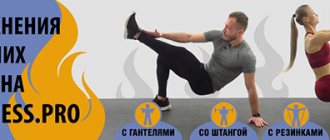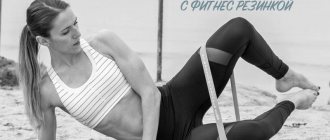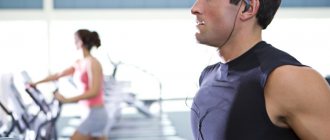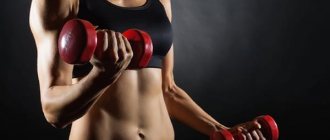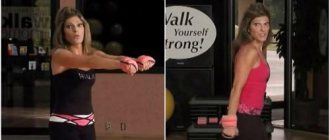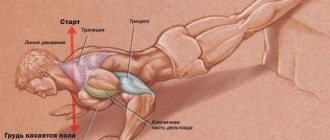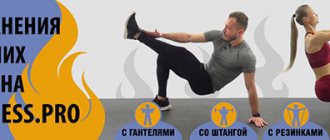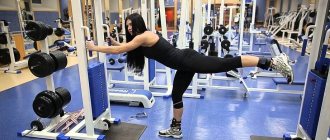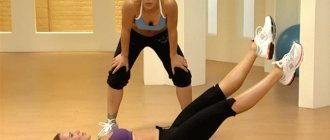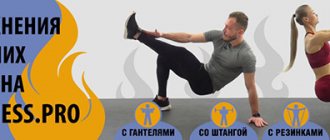The downward press exercise in a block simulator (block) pumps the lateral as well as the long head of the triceps, highlighting the lateral part of it. Formative exercise.
The cable press puts emphasis on the lateral head of the triceps, giving the entire muscle a distinct horseshoe shape that is advantageously visible from the side of the arm.
The more developed the lateral head of the triceps is, the wider the top of the arm appears when you look at it from the front. The downward press is also very effective at cutting the dividing line between the triceps and biceps.
Be sure to include the press down in your strength training program if you are involved in shot put, basketball, gymnastics, boxing, hockey, swimming, tennis, badminton.
Bent press in a block machine - triceps exercise
Correct grip of the barbell
When you lift weights, your grip can improve (or hinder) your ability to perform a particular exercise. Small changes in the position of your hands, thumbs, or wrist angle can have a big impact on how you move during an exercise, as well as the weight you can use in it.
In my practice, I have seen a large number of grip errors, but 3 of them seem to me to be the most common. The good news is that they are fairly easy to fix, which in turn will pay huge dividends for you. Don't let an incorrect grip hold back your training progress. Today we will fix these 3 most common grip errors.
Mistake #1: Benching Your Wrists on the Bench Press
Curling your wrists when doing the bench press (with a barbell or dumbbells) is the most common mistake I see. You, probably, could also see it or admit it yourself. I also made this mistake for years. This is what it looks like in the photo (on the left):
Athletes make this mistake by allowing their palms to face upward rather than their knuckles. Why is this happening? Primarily due to insufficient stability in the wrists and grip strength. Although it may be that the person simply has not yet learned how to hold the bar correctly. Or he learned, but still can’t get rid of making old mistakes.
To correct this, focus on keeping your wrists straight and making sure your knuckles are pointing up toward the ceiling. It should feel like a punch. You don't apply it to the inside of your wrist. It is as if you are pointing your knuckles towards the target of the blow. The same thing happens when doing the bench press.
I've seen people lift an extra 30 pounds on the bench press just by correcting this grip error. If you do it too, then correct it immediately!
Mistake #2: Using only a different grip in the deadlift
Using an alternate grip (one palm on top and the other on the bottom of the bar) when performing deadlifts is a common practice. Although it cannot be definitely called undesirable, it can cause some harm. Constantly using a different grip in the deadlift can lead to imbalances in the body. How exactly? You lean forward towards the hand that is gripping the bar from below. This results in a subtle but very strong twisting movement in the body. This also increases the stress on the spine, which in itself is not good, especially when you are lifting heavy weights.
Another imbalance occurs in the development of the biceps. The biceps of the hand with which you grab the bar from below work much more actively than the one with which you grab the projectile from below.
I can't say for sure that an overhand grip is "good" or "bad", but I believe that a lock grip (in which the thumb is between the bar and 2-3 fingers of the hand) is the best option for deadlifts. Many may find it inconvenient or completely unsuitable for this exercise, but try it anyway. By using this grip, you will likely notice that you can lift more weight and do it more safely. A good way to get into lock grip practice is to start with a regular overhand grip.
If you still decide to stick to a different grip, then at least alternate hands, alternately taking the bar from below or from above with different hands in each new approach.
Mistake #3: Closed grip in lat pull-downs
If you use a closed grip when rowing a block to the chest, you will likely limit the work of the target muscles, namely the latissimus dorsi.
Although it may seem counterintuitive, to engage your back muscles more actively in this exercise, you must eliminate your thumbs from the grip. This will force the latissimus muscles to work more actively, as well as other muscle groups of the back, rather than the arms.
Many people have difficulty doing chest rows because the arm muscles tire faster than the back muscles. In these cases, you finish the set with minimal work on the target muscles, since the closed grip engages the muscles of the forearms. Instead, grab the handle with an open grip. First of all, this will allow you to transfer the load from your forearms and biceps to your latissimus dorsi. The first jerk in this exercise should always come from the back muscles.
Use these 3 tips in your training and the results will follow.
https://www.stack.com/a/grip-mistakes-on-bench-press-deadlift-lat-pulldowns
Basic mistakes
Horizontal rows in a block simulator, if performed incorrectly, will turn from a useful and effective exercise into a harmful and even dangerous one. By violating the technique, you risk tearing your back muscles, getting lumbar osteochondrosis, and pulling your biceps.
The technique was developed taking into account physiology and anatomy in order to minimize the risk of injury and pump up muscles.
- The back is round. Horizontal rows in a block machine involve static tension of the back extensor muscles. In a straightened position, the back does not receive a critical traumatic load, and in a rounded position, the lower back suffers greatly.
- Look down. You need to look forward so that the spine is in the right condition.
- We pull the weight with our hands. There are special exercises for biceps, why train them here? Pull the weight with your back. To do this, we first pull by bringing the shoulder blades together. We reduce them as much as possible, all the way. Then we bring the weight up with our hands. This way, starting from the back will eliminate the dominance of the biceps in this exercise.
- Excessive forward bending. You don't need to work your lower back, moving like a pendulum. The horizontal block pull is done not with the lower back, but with the lats.
- Jerks. We remember that you need to do the exercise slowly and thoughtfully. Feel every movement, listen to which muscles are working. After all, who, if not you, will do this? No one can do it except you.
- It is not a good idea to push your feet off the supports during the exercise. Because this is pure cheating. And a waste of energy. The weight is distributed between the muscles of the torso, and the back does not work.
Benefits of exercise for muscles
For a long time, it was a common belief in the bodybuilding community that incline bench presses were best suited for working the upper pectoral muscles. But, as studies have shown, this position slightly increases the performance of the movement compared to the flat bench press, while the physical load on the posterior deltoid increases by about 80%. At the same time, experiments have shown that when working with a barbell while lying on a flat bench and grasping the bar with a reverse grip, the effectiveness of working the upper pectoral muscles increases by 30%.
During the exercise, the following are under tension:
- large clavicular muscles;
- pectoralis major muscles;
- anterior deltoid muscle bundles;
- trapezoid;
- triceps;
- wrist flexors.
Thus, when performing a bench press, you can work not only the chest, but also the arms, as well as the upper back.
The exercise is recommended for use in cases where the pectoral muscles lag too far behind other muscle groups in growth; with weak triceps; as well as for variety of physical activity during training. You should not perform the bench press without a partner for backup and if you have biceps, shoulder injuries, or elbow pain.
Preparation for execution
Many people need to “mentally prepare” so as not to immediately take on the maximum weight. It’s impossible to hit anyone with this, but it’s easy to injure your shoulders. If you need to stand in front of the block with your shoulders rounded forward, the weight is too heavy, you need to take fewer tiles.
This exercise usually ends a bencher's or bodybuilder's workout. If used as a warm-up exercise, it is performed with rubber, or with minimal weight. When working the triceps in isolation with just this exercise (for example, during rehabilitation or in a program for a beginner), you need to warm up the joints before you start moving. Then – work with minimal weight.
One-arm press with reverse grip
| Effect on muscles: Triceps: Long Bunch Triceps: Middle fascicle Triceps: Lateral bun |
Description
This exercise works great on the lateral and inner head of the triceps. The more developed these muscles are, the more impressive the upper arm will look, especially from the back. The downward press is used to create a clear separation of the triceps heads and add additional “striation” to the triceps.
The strength and speed of any pushing movement primarily depends on the strength of the triceps. The exercise is necessary for those who play tennis, karate, hockey, shot put, volleyball and basketball.
Exercise technique
Stand sideways to the machine, so that your right hand is in the same vertical plane with the upper block. Attach the D-handle to the cable and grab it using a reverse grip with your arm pointing upward.
Move your right leg forward slightly so that your left thigh does not prevent your arm from straightening in front of your body. Shoulders should be straightened, back straight and slightly arched in the lower back. The working arm should be slightly bent at the elbow in front of the cable, the elbow should be as close to the right side as possible, and the forearm should be in line with the cable and directed towards the upper block. The load is lifted from the blocks due to the tension of the cable - this position will be the starting position.
The elbow should be motionless. After inhaling, hold your breath and begin to extend your arm at the elbow, in front of your torso (while not going beyond the plane parallel to your torso). When your arm is fully extended, exhale, contract your triceps as hard as you can and leave your arm in that position for a couple of seconds. Smoothly bending your arm in front of your body, let the handle return to its starting position, but not higher than chest level. During the exercise, the load should not touch the stops.
Having done the required number of sets with one hand, turn on the other side and repeat the same manipulations with the other hand - this will be one approach.
Recommendations
The entire time the exercise is performed, the abdominal and lower back muscles should be tense, the torso should maintain a vertical position, and the spine should maintain a natural curve. The working hand should be locked at the wrist until you complete the set. The hand and forearms are on the same line.
The working elbow should remain motionless and pressed to the side of the body. When you move your elbow to the sides, the load is distributed unevenly and the effectiveness of the exercise decreases. This exercise also works the inner head of the triceps, it is this muscle that begins to extend the arm. If your goal is to work it out, stand facing the machine and extend your arm in a plane perpendicular to your torso.
This exercise has such a variation as “press down with a reverse grip with two hands”: For this exercise you need a short straight rotating handle. When performing it, first of all, you work out two heads of the triceps: external and internal.
Press to the bottom in a block machine
The downward press in the block pumps the lateral (side) part of the triceps as well as the long head of the triceps, forms relief and highlights the side part.
Execution technique
- Attach a rope handle to the body that extends through the top block. Move a little away from the projectile and grab the handle with a simple grip (palms facing each other). Place your feet parallel, stepping one leg back slightly.
- Slightly (12-14°) tilt your torso towards the apparatus and move your elbows slightly forward. In the starting position, the torso is tense, and the hands are approximately at shoulder level.
- Keeping your elbows close to your sides, take a deep breath and, stopping your breathing, straighten your arms down.
- During the entire exercise, do not move your elbows, bend forward or squat. At the top, your arms, torso and legs must remain motionless until the end of the set!
- When you spread your arms down, it is important: as soon as your little fingers are below your elbows, try to slowly turn your hands and move the handles to the sides so that when you straighten your arms as much as possible, your palms are facing your hips.
- Straightening your arms as much as possible, exhale and hold this position for a couple of seconds.
- Slowly bending your arms, allow the handle to rise up until your hands are slightly above your elbows and begin the next repetition.
Block press
- To stretch the triceps head strongly in the starting position, tilt your torso slightly forward and move your elbows slightly in front of your torso.
- Do not relax your arms during the movement and do not straighten your wrists! Turning the hands with the palms to the hips is achieved only with the help of supination of the forearm (turning it around its axis towards the outside). During the entire set, the wrist is fixed: the forearms and hands are in the same line.
- By turning your hands with your palms towards your hips, you improve the work of the triceps.
- The main load in the downward press falls on the lateral (side) head of the triceps. But, you can force the long head of the triceps to work at full strength. To do this, make your elbows slightly extended in front of your torso.
- Do not lean your torso forward or pull your elbows back, helping yourself to press the handles down. This moves the focus of the load from the triceps to the rest of the muscle groups.
- This muscle has a beautiful horseshoe shape that looks great on the side of the arm. The better the lateral head of the triceps is developed, the better the upper arm looks. Also, the downward press severely cuts the line of separation between the triceps and biceps. Always include the press down in your exercise program if you play basketball, swimming, badminton, gymnastics, boxing, hockey, or tennis.
Application
Intended for: Everyone, from beginner to master.
When: After completing a triceps workout. Before pressing down, do a barbell press, this will increase the effectiveness of the workout, as well as straightening your arm with a dumbbell from behind your head.
How much: 3-4 sets of 10-14 repetitions.
Bench press with a narrow grip: advantages and features
Main advantages:
- Basic exercise, accordingly, perfectly builds muscle mass;
- Increases results in the classic bench press by strengthening the triceps, chest muscles and anterior deltoids;
- A narrow grip is universal. With its help, you can solve various problems, for example, increase mass, develop strength, improve relief (depending on the number of repetitions).
The athlete must establish a “connection” between the “brain and muscles”, do not use a grip that is too narrow, and do not choose heavy equipment to avoid the involvement of third-party muscles.
Close grip press - execution technique
We focus not on weight, but on technique:
- IP: lying on a horizontal bench, hands shoulder-width apart, remove the apparatus and place it above the middle of the chest;
- Slowly lower the barbell to your chest, lightly touching it;
- Pause for a second;
- Press the barbell up, returning to IP.
We lower the projectile as we inhale, raise it as we exhale.
Please note that your elbows should be pressed as close to your body as possible. The bench press with a narrow grip bench press with the correct technique will allow you to achieve the desired result in a matter of months.
Practical recommendations
The close grip press has certain features:
Distance - at least 20 cm. But keep in mind - the indicator is individual
Pay attention to the width of your shoulders and be guided by this indicator. The principle “the narrower the better” does NOT work here; Do not straighten your arms completely at the top point, this will help maintain healthy joints; The period of lowering the bar should take exactly 2 times longer than lifting the projectile; Be sure to perform the exercise with a partner when working with heavy weights; Do not allow inertia or oscillations of the bar - otherwise (at best) non-target muscles will be involved, and the triceps will not be able to be effectively worked; For the first time, use an empty bar or minimal weight to practice the technique.
There is no need to be embarrassed by other fitness center visitors. As soon as you see that the exercise is performed correctly from a technical point of view, you can take more weight.
The bench press with a narrow grip requires a high concentration of attention - it is strictly forbidden to stop at the lowest point, so as not to shift the load to the pectoral muscles. Do not push the projectile with your chest, do not arch your back while squeezing the barbell. Try to fix your whole body in one position and work only with your hands.
Elbows confuse newbies. Trying to hold the barbell in a stationary position, many people forget about their joints. The elbows move in different directions when squeezing the projectile, thereby switching the load. Make sure that they are always strictly pressed against the body.
Possibilities and variations of close-grip presses
When pressing with a close grip, you can use not only the classic straight bar. Allowed:
Narrow EZ Bar Press
Narrow press on the Smith machine
https://youtu.be/g2KApb6iKEY
The Smith machine is one of the best solutions for beginners. During the exercise, you will not have to be directly distracted by fixing the bar in the correct position. The use of a curved bar also helps stabilize the projectile. It is considered more anatomically correct and allows the triceps to work in the usual direction.
If you want to diversify your training, you can periodically include a reverse grip bench press in your program.
To whom, when and how much
To whom
For beginners and pros.
When
At the beginning of the training, a basic exercise. Then proceed to reverse triceps push-ups.
How many
Depending on the goal (number of approaches – from 2 to 5):
- For strength – 3-5 repetitions, heavy weight;
- For mass – 10 repetitions, medium weight;
- Mass + strength = 7-8 reps.
This exercise allows you to thoroughly work out the triceps, making your arms more prominent and massive. Follow the technique to achieve maximum effect.
Masses and relief to you!
Tips: Pressing to the bottom in a block machine
1. To ensure that the long head of the triceps is well stretched in the starting position, tilt your torso slightly forward and your elbows slightly extended in front of your body.
2. Do not loosen your grip during the exercise and do not straighten your wrists! The turning of the hand with the palms towards the hips occurs only due to the supination of the forearm (rotating it around its axis towards the outside). Throughout the entire set, the wrist is fixed: the hands and forearms are extended in one line.
https://youtu.be/DG_qts6PodE
3. By turning your hands with your palms facing your hips, you strengthen the contraction of the triceps.
4. The main load in the downward press falls on the lateral (side) head of the triceps. However, you can get the long head of the triceps to work at full strength. To do this, keep your elbows slightly extended in front of your body.
5. Do not tilt your torso forward and do not pull your elbows back, helping yourself to push the handles down. This shifts the focus of the load from the triceps to other muscles.
6. You can use heavy weights in this exercise, but without fanaticism! The weight of the load should not be an obstacle if the correct technique and form of movement are observed.
If you find an error, please select a piece of text and press Ctrl+Enter.
The triceps, the largest muscle in the arm, requires careful and varied training of all three heads. Only in this way can it be made to “grow” qualitatively and correctly, increasing the size of the arm.
By the way, many beginners have the mistaken opinion that to create massive and thick arms you need to purposefully “pump up” your biceps. Of course, this muscle group also requires attention, but the volume is created by the triceps, which covers the back of the arm from the shoulder to the elbow. And among the exercises (of which, by the way, there are many) for working it out, one of the most effective is the downward press, performed in a vertical block machine. Thanks to several grip options (which we will look at below), you can achieve a high-quality load on all three heads of the muscle, right down to the deepest fibers.
Working muscles
Since the movement occurs in one joint - the elbow - the press down is an isolating exercise. Consequently, the load is concentrated only on the main group responsible for elbow extension - in fact, the triceps itself.
Anatomically, the muscle group consists of three heads of different lengths:
- Medial - located on the inside of the arm and is the smallest head. Works from the very beginning of movement (extension)
- The long one is located at the back (therefore it is often called the posterior head of the triceps) and is the largest. Takes an active part in extension, and also fixes the elbow joint near the body.
- Lateral – located at the back and side of the arm. It is its correct development that makes it possible to give the hand a “horseshoe” shape. It comes into operation if the force of the medial head is not enough.
Depending on the grip used, you can achieve different load distribution on different heads.
To whom, when and why
Despite the fact that the press down is not a basic exercise, it can safely be called a universal way to develop triceps. It is equally useful to do it for both beginner athletes practicing bodybuilding and experienced bodybuilders, both during cutting and when gaining weight - naturally, with its own nuances and characteristics.
The exercise is not very effective only for those who just recently came to the gym and have not yet managed to gain muscle mass. In this case, it is best to pay attention to the “base”. In particular, to work the triceps, this is, first of all, performing a bench press with a narrow grip.
For all other athletes, cable extensions (arm extensions on a block) are one of the most effective ways to build beautiful and powerful triceps.
The exercise is performed on the day of arm training (or, if you train biceps and triceps separately, then on the day of triceps training). Since it is an isolating exercise, it should be placed after the “base” and more complex exercises - bench press, push-ups (on uneven bars or from a bench) and French press.
As mentioned above, the exercise is equally relevant both for increasing volume and when working on relief. By the way, when performed repeatedly with minimal weight, a fairly high-quality and powerful “pump” of the triceps is achieved, which is an excellent stimulator of muscle growth.
The exercise is included in programs for high-quality and deep study of all three heads of the triceps, and the ability to shift the emphasis to each of them.
Execution technique
Extension is performed using the top cable of a vertical pulley machine, which is an essential device for any gym. You can use several different handles: straight, curved at the edges, rope, single.
- We stand in front of the simulator stand. We tilt our body forward a little, raise our arms, grab the handle and lower it down. Starting position – the arm from the shoulder to the elbow is perpendicular to the floor and bent at the elbow joint.
- We begin the movement by smoothly extending the elbows until the arm is completely straight.
- After holding at the bottom point, we smoothly relax the triceps, returning the handle back.
- Repeat the required number of times.
Important nuances and tips
- Working weight. The exercise is performed with medium or minimal weight. When working with maximum weight, it is very difficult to avoid “cheating” - swaying of the body.
- Number of repetitions. When performing a downward press, a large number of repetitions is important (both during “drying” and when dialing) – from 10 to 20 in 1 approach.
- Execution speed. You should move smoothly, avoiding inertia, extend your arms slowly, and bend them a little faster.
- Body and legs. During execution, the movement is performed only in one joint - the elbow. The rest of the body should remain motionless until the very end of the exercise. This also applies to the arms from the shoulder to the elbow - they must be perpendicular to the surface.
- Delay at the bottom. Holding with your arms fully extended is a fairly effective way to maximally target your triceps. The technique, in principle, is not mandatory, and it is best to use it periodically to change the type of load. For example, perform two sets moving continuously, and the third with a delay.
- Holding your breath. Since the spine does not receive significant load, it is not necessary to hold your breath.
- Body tilt. The more you lean your body forward, the more the load shifts to the long head of the triceps.
- Brushes. When working with a rope handle (your hands face each other in the starting position), try to turn your palms down - this will put even more stress on your triceps.
- "Cheating." When working with large weights, make sure that the body does not swing, helping to “add on” the handle. If this cannot be avoided, reduce weight.
- The exercise can be used effectively in supersets. Alternatively, a combination with a French press or exercises for developing biceps is perfect.
Technique for performing a fitness element
The reverse grip barbell press is traumatic, so it is necessary to study the technique of performing it in advance in order to avoid mistakes in the process of fitness training.
- The barbell racks are installed so that when lying down the athlete can hold onto the bar with slightly bent arms. This will help you carefully remove and return the bar to its place. For insurance, you must ask a partner or trainer to be present throughout the entire exercise.
- For beginners, it is recommended to leave the bar empty: 20 kg will be enough to start with. Girls can choose lighter bars.
- Lie with your back on the bench so that the barbell is located above your head. The feet rest the entire sole on the floor, the knees are bent. The back, buttocks, shoulders and head are pressed against the bench.
- Take the bar with a reverse grip: the inner side of the palms should be facing the face; The hands are placed slightly wider than the shoulders.
- Remove the bar from the racks, straightening your arms.
- Take a deep breath and slowly lower the bar until the bar touches the lower part of the chest.
- As you exhale, straighten your arms, pushing the sports equipment upward.
- Fix the position at the top point for 1-2 seconds, then slowly return the barbell down.
Having completed the required number of repetitions, carefully return the sports equipment to the racks. With a normally selected weight, the athlete should perform 3 sets of 10 repetitions. If the physical activity seems easy, then hang pancakes on the bar; if you couldn’t complete 10 repetitions, you need to find a lighter bar.
Efficiency Tips
- To involve the triceps in the work, use a rope handle or attach rubber to the upper block evenly. This version of the exercise does not allow you to perform it with heavy weights, but this is not necessary. The straight handle helps to lock the hands more and perform the movement more isolated;
- A short pause at the lower permissible part of the amplitude will help to work the triceps more efficiently without using weights that are traumatic for joints and ligaments. In this case, there is no need to “press” and “insert your elbows” until it clicks;
- A “scissors” stance, when one leg is placed in front of the other, will help to actively engage the triceps in the work, if a person does not bend over like that, and stands stably, preventing the body from “working extra” and pushing the weight down due to inertia. Stepping is not a technical error, but rather a technique that helps some athletes;
- You can use a rigid handle to handle more weight. This makes sense if you bench press and need additional strength work after the main one. For beginners and those who train triceps in pump mode, it is better to use a cable handle for now;
- If your back gets tired during an exercise, it makes sense to change your legs;
- To maintain a smooth pace, you should do the exercise in a concentrated style, slowly extending your elbows for 2-3 counts;
- The exercise, when the elbows are extended from behind the head, significantly involves the shoulder joint in the work, and therefore is more difficult. It is demanding on the athlete's flexibility. If your shoulders are not very good yet, you should abandon this variation of the exercise.
Reverse grip press diagram
1) Lie down on the bench and raise your legs on the bench so that your lower back is pressed tightly against the bench, you don’t need to bring your shoulder blades together. 2) You need to lie as far behind the bar as possible so that it is convenient for your partner to give it to you and belay you, and also so that and you yourself didn’t need to move your arms far.3) Take the bar as narrowly as possible with a reverse grip, but so that you feel comfortable and so that you can turn your elbows towards the body, that is, a grip wider than your shoulders.4) Move your hands with the barbell forward, so that at the bottom point your elbows form a 90° angle, and the bar is just below the solar plexus. 5) Lower the barbell down, but do not touch the body, and then, as you exhale, press the barbell up, straightening your elbows to the end, leaving only that is, bend your elbow just a little so as not to injure your joints.
Reverse Grip Press - Notes
1) The exercises are performed with the help of a partner, since a partner must help remove and put the barbell on the racks, otherwise you can get injured or drop the barbell on yourself. 2) The amplitude of the movement should be from yourself, not towards you, so that the load is accumulated in the triceps, and did not move into the deltoids.3) Be sure to hold the barbell with a closed grip in order to control it, otherwise you can drop it during failure repetitions.4) It is preferable to perform the bench press with a reverse grip in the range of 10-15 repetitions, since the amplitude is quite short, and therefore, each repetition does not take very long.5) Be sure to monitor the position of your elbows relative to your body, as this is what determines whether all three triceps bundles will be engaged.
Anatomy
The triceps muscle of the arm consists of three bundles, which differ in length and strength, as well as in their ability to bear the load. When the load is small and the elbows are separated from each other, the medial bundle takes on the entire load; if the load increases, then the lateral bundle is also loaded, but the internal triceps bundle works only when the athlete turns his elbows towards the body. That is why it is necessary to perform the reverse grip press with a fairly large weight that you can control, but which can force the body to use all three triggers.
To summarize, the reverse grip press is a very effective compound exercise for working the triceps muscle, but should only be performed by experienced athletes. The key points are the position of the arms relative to the body and the angle of bend of the elbow joint, which determines the effectiveness of the exercise and the degree of loading of the triceps. When including such a bench press in a superset, it must be performed first, since the position of the barbell fixes the biceps. If you load the biceps first, you will simply shift the center of gravity, which will change the load factor on the triceps. Do the exercise correctly, because the one walking in the right direction will overtake the one running astray!
More information on the topic: https://lift4power.ru
Aerobics
After strength training, move on to aerobic exercise. Suitable dance aerobics, step, “ski” or “stair” machine, stationary bicycle or gliding machine.
Tuesday Friday
Goal: Slim lower body.
Warm-up: 5-10 minutes of walking at a leisurely pace.
Training style: Moderate weight and high (12–15 repetitions) repetitions.
Training program
| Exercises | Sets** | Repetitions |
| Barbell squats with wide stance | Warm-up set (light weight) 3 * | 10–12 12–15 |
| Hack squats, legs together | Warm-up set (light weight) 3 * | 10–12 12–15 |
| Leg curls in the simulator | Warm-up set (light weight) 3 * | 10–12 12–15 |
| Deadlift with dumbbells | Warm-up set (light weight) 3 * | 10–12 12–15 |
| "Twisting" with rotation | 1 | Not less than 25 |
| Leg raise with rotation | 1 | Not less than 25 |
*Increase the weight for each subsequent set. **If you've never done weight training before, do only three sets (one warm-up and two loaded).
Aerobics
After strength training, move on to aerobic exercise. 20-30 minutes of walking at a brisk pace.
Wednesday/Sunday
Rest
Saturday
Goal: Fat burning
Aerobics
Start with five minutes of walking at a leisurely pace (warm-up). Then 30-45 minutes of intense training: ideally, 10-15 minutes on a stationary bike, 10-15 minutes on a rowing machine, and 10-15 minutes on a ski or stair machine. Don't forget to walk a little after your workout to get your heart rate back to normal. If all or some exercise equipment is not available to you, you can do traditional types of aerobics, such as walking with weights, race walking or running, etc.
Remember: method and consistency are the basis of any success!
Press down technique
It can be performed in several ways, for example, with one or two hands. Let's consider the technique of the second option:
- IP – leaning forward, grab the handle of the block with a narrow grip;
- Palms face the floor, elbows pressed to the body;
- Pull the cable to the level of the upper part of the pectoral muscle;
- We lower our arms until they are fully straightened and raise them back (to chest level);
- Repeat the specified number of times.
When doing arm extensions from the upper block, all attention should be paid to technique. Heavy weight will not help you develop muscles stronger or faster, but will only reduce the effectiveness of your workout.
One-arm press down:
- We take the handle of the block, palm facing inward;
- We make a slight tilt in the direction that will be involved;
- Pull the handle to the level of the upper chest;
- Extend your arm completely, you can hold the block with your other hand or place emphasis on your thigh;
- Return the handle to the top of the chest and repeat the required number of times.
Taking turns is quite difficult. It is necessary to maintain balance and monitor technique even more carefully.
Extend your arm as you exhale, bend it as you inhale.
Please note - when working alternately, the palms are facing inward (towards you), when working with two hands, the palms are facing down
Features of arm extensions from the upper block
The downward press is an isolating exercise, the entire load goes to the lateral fascicle of the triceps - it is this that is visible to the naked eye when looking at the athlete from the front. It does an excellent job of giving the muscle relief and shape.
Other subtleties:
- Under no circumstances should the shoulders be involved in the work. The entire load falls directly on the triceps;
- For best results, lean forward slightly (about 10-15 degrees). You also can’t bend over too much - this way you will put pressure on the handle with the weight of your own body, which will negatively affect the training of the target muscle;
- Watch your elbows - their position should be strictly fixed to avoid the similarity of arm extension on a standing block with classic types of bench press;
- It is allowed to put the opposite leg forward to achieve the most stable position.
- You can choose a rope handle, with this you can diversify the exercise.
Extension of arms from the upper block with a rope handle:
Please note that a lot of weight is not needed in block arm extensions. Use approximately 10 kg at the initial stage, over time you can increase this figure to a working weight that is comfortable for you
By the way, avoiding injuries to the elbow joint and wrist is quite easy - keep both of them motionless throughout the entire approach.
To whom, when and how much
The exercise should be performed:
To whom
For beginners and pros.
When
At the end of the workout, after performing bent over dumbbell extensions.
How many
Perform 3 sets of 15 repetitions.
The exercise is truly highly effective. Be sure to include it in your training process; you will easily appreciate its benefits.
Masses and relief to you!
Press to the bottom in a block machine
The downward press exercise in a block simulator (block) pumps the lateral as well as the long head of the triceps, highlighting the lateral part of it. Formative exercise.
The cable press puts emphasis on the lateral head of the triceps, giving the entire muscle a distinct horseshoe shape that is advantageously visible from the side of the arm.
The more developed the lateral head of the triceps is, the wider the top of the arm appears when you look at it from the front. The downward press is also very effective at cutting the dividing line between the triceps and biceps.
Be sure to include the press down in your strength training program if you are involved in shot put, basketball, gymnastics, boxing, hockey, swimming, tennis, badminton.
Bent press in a block machine - triceps exercise
Inclusion in the program
Many people warm up with this movement. Of course, we are talking about the bench press. If we do the same, it is worth remembering the rules. To begin with, a joint warm-up and a couple of sets of extensions with light rubber. Then - 1-2 approaches with minimal block resistance. Those intending to bench press do not need to do high-rep pump sets in order to “work the triceps in advance.” This approach does not work well if a person really cares about results in the main exercise and healthy elbows. The purpose of the warm-up is to increase the local temperature of the muscles, improve blood supply and prepare for the main movement, and not to tire the muscles so that extension becomes completely impossible.
In classic fitness plans, the cable extension is the last triceps exercise. Here it is also important not to “insert” your elbows too actively, and to avoid too much inertial load. The purpose of the exercise is to work the triceps, and not to make the arms simply overworked, and the person gets injured due to a sharp “insertion” of the elbows.
In addition, you need to make sure that the extension is actually training the triceps, and not the “whole body”. Of course, the temptation to become known as “the strongest in the room” by extending your arms with the largest number of tiles is great, but you shouldn’t give in to it and just waste time, “swinging by inertia.”
Usually the movement is performed in a mode of 12 or more repetitions, but it is also possible to work in the range of 8 repetitions or even less.
